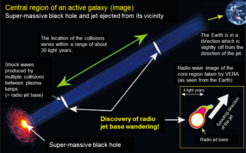Discovery of the wandering base of a radio jet after a major X-ray flare
July 1, 2015
Based on VLBI observations of the radio source, Markarian 421, a team including Shoko Koyama from the MPI für Radioastronomie, led by Kotaro Niinuma (Yamaguchi University) has discovered have discovered a new phenomenon in which the position of a radio jet base, a type of object which had been thought to be stationary, "wanders" widely along the jet axis. Radio jets ejected from the vicinity of super-massive black holes lurking at the center of active galaxies have been being observed for many years, but the team shows the first time anyone in the world has directly detected this "wandering phenomenon" of the radio jet base. These results were published in the latest issue of the Astrophysical Journal Letters, see here. Additional information, in the press release of Yamaguchi University, in English and in Japanese, as well as in the National Astronomical Observatory of Japan in Japanese.




